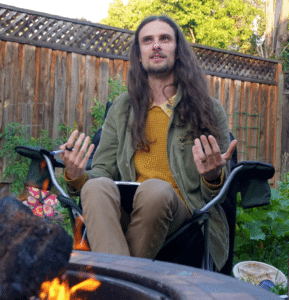By Jennifer Wadsworth
For a proper psychedelic trip, the late ethnobotanist Terence McKenna famously prescribed what he called ‘the heroic dose’ of magic mushrooms: ‘Five dried grams and silent darkness.’
Josh Tiefer gobbled up a gram less, but on an empty stomach and a broken heart. Rather than darkness, he opted for a late-night showing of The Last Samurai.
He was 24 at the time, battling the depressive fallout of a breakup and newly obsessed with McKenna’s gospel of chemically induced enlightenment. In the theater, the psilocybin began to cast its hallucinogenic spell.
“Something happened,” Tiefer recalls, “because I was like, ‘This movie’s getting pretty good.’”
Motion trails and vibrant colors overwhelmed his vision. But the euphoria gave way to a soul-chilling terror, a sense that some unfathomable force could delete his soul from the cosmic record—total erasure, a fate worse than death. Horrified, he shut his eyes and shrunk into his seat, crippled by the sense that, in some inexplicable way, everything hung in the balance.
Then it started to get really good.
“I had my beanie in my hand,” he says. “You know, like my beanie hat, and suddenly everything was very, like, the essence of beanie. Like, you know, the way the actors were up on the screen, you know—the essence of beanie. The patterns of the beanie were shown to be evident in all things in the fu**ing world.”
In a flash to the present, he realized he’d been pressing into a stranger—a preternaturally patient stranger—in the next seat. Tiefer looked down to see that his feet had stretched a thousand miles underground “like a bunch of roots and shit.” Then, his mind, forming what seemed like infinite synesthetic bonds between senses and worlds, sparked a revelation of the Buddhist precept of interconnectedness. Or, as Tiefer verbalized it, “the universe is like one mush” and he was mushing into everyone and everything.
“Like, I’m a Siamese twin with this person over here,” he says, gesticulating with one hand while gripping a sketchpad in the other. “But the way the actors were expressing themselves was also shown to be, like, this similar medium that was me, and all this other shit at the same time.”
When he summoned the wherewithal to open his eyes, he saw the movie screen swirling with watercolor-like canyons, vibrant greens and blues and shifting pixels, fractals and grids. The performative emotions of the Tom Cruise warrior epic struck open some untapped well of feeling. Once the credits began to roll, Tiefer’s friends pried him from the chair and took him to Denny’s, where he glutted and purged.
“Most things are disappointing, but this was the real deal,” says Tiefer, an artist by occupation who’s 36 now and recounting his trip to a gathering of psychonauts and inquiring minds. “I’ve been too chicken shit to do it ever since.”
His audience—a group of about 20 or so people seated around a firepit on an assortment of mats, blankets, benches, chairs and pillows in a meadowy backyard—laughs and applauds at Tiefer’s conclusion.
“I’ll have what he’s having,” a bespectacled university professor quips.
For starters
It’s witching hour on a Sunday in May, and we’re about four-and-a-half hours into a potluck raising money for a kilo of pure MDMA. Or as it’s colloquially known, ‘molly’ or ‘ecstasy.’ There’s an eclectic turnout of academics, ravers, techies, a white blazer-and-aviators-clad financial adviser, a toddler, artists, musicians and the husband-and-wife hosts Nadia, a Belarus transplant and therapist, and Dmitry V., an aspiring therapist and Russian émigré.
“It’s great to have a whole night just devoted to psychedelics,” says Dmitry, whose gaunt frame and back-length hair make him look like a Byzantine icon. “There needs to be a coming out in this community.”
Despite the talk of ‘coming out’ for the cause, though, few people want their full name publicly associated with the gathering and Dmitry preferred to whittle his surname down to its first-letter initial for this story.


One attendee remarked on the dilemma of wanting to do her part to legitimize the psychedelic scene with her open support, but being afraid of the stigma associated with drugs as criminalized as cocaine.
Indeed, the federal powers that be regulate acid and psilocybin mushrooms as closely as crack and heroin. Yet psychedelics have outgrown their hippie-fringe roots to become, to some extent, part of the mainstream—particularly in Silicon Valley, where users typically lead otherwise straight lives. Government restrictions have started to ease up thanks to the work of advocates who defied the taboo and rebranded psychedelics as therapeutic. The late-April fundraiser marked one of hundreds around the globe to benefit the Santa Cruz-based Multidisciplinary Association for Psychedelic Studies—MAPS for short—an organization devoted to researching the medicinal value of psychedelic drugs and cannabis.
Their primary goal of these psychedelic dinners is to collect $400,000 to buy 2.2 pounds of pharmaceutical-grade MDMA as a potential legal treatment for post-traumatic stress disorder. MAPS spokesman Brad Burge says that’s how much it costs for an entirely new supply approved by the U.S. Food and Drug Administration.
The California nonprofit has been using a batch of MDMA made in the 1980s by Purdue University chemist David Nichols. But regulators want to keep their eyes on the entire manufacturing process before it signs off on third-phase clinical trials for up to 400 patients. An estimated 5 million people suffer from PTSD, a condition triggered by rape, combat, natural disasters or serious accidents. Left untreated, it sends the afflicted into life-threatening depression and substance abuse. Antidepressants and antianxiety medication only treat symptoms, while traditional talk-therapy could take years to pinpoint root causes.
In the MAPS trials, patients take a carefully measured dram of MDMA and spend the day discussing their trauma with therapists. Psychotherapy in general and PTSD therapy in particular focus on exposing a patient to distressing thoughts to eventually desensitize them. MDMA’s capacity to suspend a person’s fight-or-flight instinct, which shifts into overdrive in people suffering from PTSD, allows them to face their traumatic memories until those thoughts lose the brunt of their power.
“The immediate effects of MDMA make people feel intimate, so there’s that bonding, that connection,” Burge says. “People tend to become more present, which lends itself well to therapy, of course.”
In his Pulitzer Prize-winning causa sui The Denial of Death, Ernest Becker points out that humanity goes to just about any length to avoid contemplating their own mortality. Life is fatal, but people forget. Trauma makes it impossible to deny. PTSD sufferers develop a heightened, crippling death-awareness.
Becker writes in his 1973 tome: “The irony of man’s condition is that the deepest need is to be free of the anxiety of death and annihilation; but it is life itself which awakens it, and so we must shrink from being fully alive.”
Yes, he derided psychedelic drugs as a Dionysian excess, bemoaning modern man for “drinking and drugging himself out of awareness.” Ironically, though, MAPS has found that a certain strain of chemical fix can help confront rather than escape one of the greatest agonies of the human condition: Consciousness of our inevitable demise.
“On some level, psychedelics push you to the brink of understanding that you’re mortal,” one of the dinner guests, a San Jose musician, explained after a colorful telling of her most memorable, jarring psilocybin trips. “You know? You’re forced to confront those fears. A lot of people are wound really tight, or stuck to this world. Sometimes you have to force your way outside of yourself to realize that to be unafraid of death means accepting that they’re part of nature and that there’s a lot more possibility than you imagined.”
For anyone who finds it odd to see MDMA classified as a psychedelic, Burge explains that it’s more an umbrella term than a scientific one. Think of it this way: All hallucinogens are psychedelic, but not all psychedelics have hallucinogenic effects. Consider MDMA a psychedelic as defined by Humphry Osmond, the mid-century British psychiatrist who coined the term for chemicals he considered ‘mind manifesting.’
“That’s what we mean when we use the word,” Burge says. “And it certainly applies to MDMA, which isn’t really a hallucinogen but definitely has psychedelic, mind-manifesting, or mind-expanding impact.”
The first two rounds of clinical trials have gone exceptionally well—with success rates up to 83 percent, according to psychiatrists involved in the research—and planning is underway for the third phase of trials, which will begin in 2017. After a few rounds of MDMA-assisted psychotherapy, several patients who took part say their symptoms of trauma have all but vanished. Doctors hesitate to use the word ‘cure,’ but four years past the first double-blind trials, the results look promising.
“It took a lot of work on the part of MAPS to get to this point, to be on the brink of FDA approval,” Burge says. “MDMA had been legal until 1985 and had been used in therapy. When it was criminalized, that put all the legal, above-ground therapeutic use to a stop. It also stopped major funding overnight. That probably set us back 30 years. There’s a lot of catching up to do.”
Psychopharmacological scholar Rick Doblin founded MAPS a year after the ban, in 1986, to research the clinical benefits of psychedelics and marijuana. While trippers generally remain discreet about their activities, especially of recreational use, MAPS has made a point of operating scrupulously above board. Under Doblin’s purview and guided by his Harvard University-honed expertise in public policy, the nonprofit has published journals, statistics, action studies and methodical protocols that slowly chipped away at some of the counterculture stigma attached to psychedelics.
The method took a few decades but seems to be paying off. To date, MAPS has raised more than $36 million, largely from individual donors and small foundations, to study cannabis and psychedelics and educate the people about their risks and benefits. The nonprofit celebrated another landmark victory in May when the U.S. Drug Enforcement Agency approved a clinical trial of marijuana to treat PTSD. Seventy-six trauma-stricken military veterans will take part in the study, which marks the first time federal regulators officially allowed research meant to make smoked cannabis a legal prescription.
Silicon Valley Gives, the region’s annual 24-hour fundraising drive that took place on May 3, gave MAPS another big boost. Together, with money raised from its 30th anniversary gala in March and some 300 grassroots psychedelic dinners like the one hosted by Nadia and Dmitry last month, the organization has raised almost half of the $400,000 needed for their MDMA purchase.
“We’ve had to combat years of negative propaganda, negative science to prove that there are legitimate contexts for these type of substances,” Burge says. “We’re always trying to bring more people into the fold by informing not just people who are already involved in psychedelic circles, but also the ones who may be on the fence or don’t know enough about it yet.”
A secondary aim of the dinner parties, he notes, is that they give people a chance to talk openly about their psychedelic experiences—or lack thereof. Some people at the San Jose event say they’ve never experienced anything more than a weed high. Still, they showed up out of curiosity, or because a friend came back from an ayahuasca ceremony or a psilocybin trip raving about the transformative effects.
“I do have to say that it’s very daring to do psychedelics,” Dmitry says, urging people to treat the psychoactive high as more than a gratuitous head change. “There’s a reason we’re all talking about it here.”
Expedited trip
At the bonfire dinner, the conversation gets headier and more numinous as the hours pass and the sun dips below the horizon. Throughout the night some 20 or so people trickle in and out of the grassy yard, where windchimes lilt in the background and guests help themselves to fruit, dolmas, hummus, tofu pot pie and a Chicago-style deep-dish pizza. Five hours in, the financial adviser exits the circle to collapse in a hammock.
Save for the craft beer, no intoxicants are consumed, though they’re the main course of discussion. People read a ‘conversation menu’ prompt to open up about their most white-knuckling psychedelic trips. Dmitry recounts a time he puddled out on acid and jumped into what seemed like another dimension, a realm in some far-flung reach of the universe. When he came to, he says, he had stigmata-like gouges on his palms.
They discuss the Silicon Valley angle, namely the industry’s not-so-secret penchant for the molecular mind show of hallucinogenic drugs. Much has been made of Steve Jobs’ reverence for psychedelic enlightenment, but McKenna—whose name comes up a number of times during the dinner party—spent a lifetime studying the intersection of new technologies and ancient pagan customs.
In Food of the Gods, published in 1992, McKenna makes the iconoclastic case that psychedelics jumpstarted human advancement by giving our mushroom-eating forebearers a leveling-up from animal instinct to higher consciousness. In the 1990s, he popularized the idea of virtual reality and accurately predicted that the internet would galvanize psychedelic subcultures by providing a space to connect and organize.
“Psychedelics are woven into the Silicon Valley ethos,” remarks a dinner party guest who declined to share her name. “I want to take mushrooms or LSD to shift my perspective before tackling a new project.”
The conversation touches on how psychedelics exploded into American culture in the 1960s, and spawned a counter-culture inherently at odds with society. But a lot of those same people grew up and brought those sensibilities to the mainstream, ideas that manifest in academia, medicine and technology. Take Google’s Deep Dream, one of the guests says. The artificial intelligence program used an algorithm to find and enhance psychedelic patterns in images.
“That’s one more example of the interplay between technology and psychedelics,” remarks one of the guests, an engineer at a local startup. Like virtual reality, he continues, a trip “isn’t real,” but can transport a person and spark some lasting insight.
The university instructor who listened intently to Tiefer’s wild account of a mushroom high says psychedelics have far more applications than medicinal use. If used with intention, he says, they could provide novel answers to not only personal pain points, but also some of the most pressing political and environmental problems.
It’s a thesis similar to Becker’s, that the root of evil isn’t humanity’s animal nature, territorial violence or innate selfishness. Rather, it’s the death-denying impulse to establish some self-serving legacy to outlast us. In Becker’s words, “Our desire for the best is the cause of the worst.”
A recurring theme from the MAPS fundraising dinner was the power of enlightenment to veer us away from those destructive, if occasionally well-meaning, tendencies. For expediency’s sake, that may entail a chemical aide.
“I think psychedelics are like a gateway to the mystical experience,” says an engineering professor, who asked to withhold his name because he doesn’t want his employer to associate him with anything illegal. “They’re not the only way to get there. You could spend your whole lifetime getting there. But psychedelics are like a helicopter ride to the top of the mountain you could otherwise climb.”
Some people may prefer the slow, steady trek, he says. But why not hitch a ride up?
“As long as you bring something back from it that’s healing or life-altering,” he advises. “Otherwise you’re kind of wasting the experience.”













